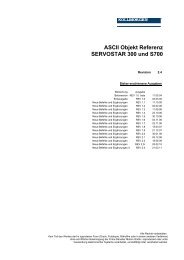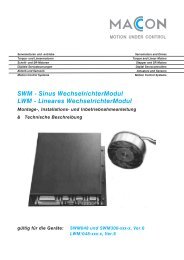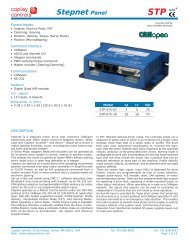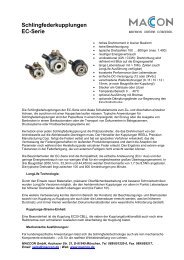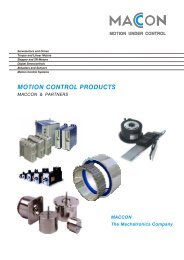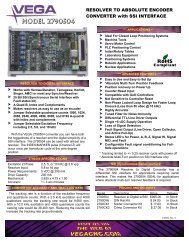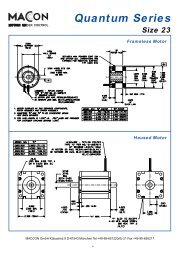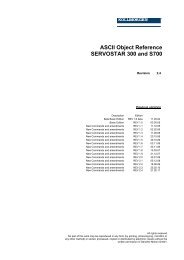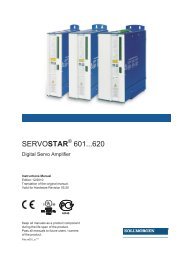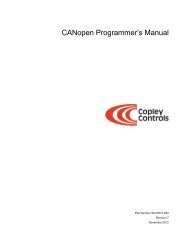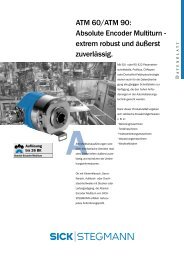Copley amplifier parameter dictionary - Maccon.de
Copley amplifier parameter dictionary - Maccon.de
Copley amplifier parameter dictionary - Maccon.de
You also want an ePaper? Increase the reach of your titles
YUMPU automatically turns print PDFs into web optimized ePapers that Google loves.
<strong>Copley</strong> Amplifier Parameter Dictionary Amplifier Variables<br />
ASCII DvcNet Macro CAN ID:sub Bank Type Description<br />
0x1D 0x1E 0x41D 0x2200 R* INT16 Analog Command Input Voltage. Also known as A/D Reference Input Voltage. The<br />
analog command voltage after offset and <strong>de</strong>adband have been applied. Units: mV.<br />
0x1E 0x1F 0x41E 0x2201 R* INT16 Bus Voltage. Also known as High Voltage reference. The voltage present on the<br />
high-voltage bus. Units: 0.1 V.<br />
0x1F 0x20 0x41F 0x2207 R* INT16 A/D Offset Value. A calibration offset value applied to the internal A/D unit. It is part<br />
of a continuous calibration routine that the <strong>amplifier</strong> performs on itself while running.<br />
Units: mV.<br />
0x20 0x21 0x420 0x2202 R* INT16 Amplifier Temperature. Units: <strong>de</strong>grees C.<br />
0x21 0x22 0x421 0x2110 RF INT16 User Peak Current Limit. Also known as Boost current on stepper <strong>amplifier</strong>s. This<br />
value cannot exceed the peak current rating of the <strong>amplifier</strong>. Units: 0.01 A.<br />
0x22 0x23 0x422 0x2111 RF INT16 User Continuous Current Limit. Also known as Run Current on stepper <strong>amplifier</strong>s.<br />
This value should be less then the User Peak Current Limit. Units: 0.01 A.<br />
0x23 0x24 0x423 0x2112 RF INT16 User I 2 T Time Limit. (User Peak Current Limit Time.) Also known as Time at Boost<br />
Current on stepper <strong>amplifier</strong>s. Units: mS.<br />
0x24 0x25 0x424 0x2300 RF INT16 Desired Amplifier State:<br />
Value Description<br />
0 Disabled.<br />
1 The current loop is driven by the programmed current value.<br />
2 The current loop is driven by the analog command input.<br />
3 The current loop is driven by the PWM & direction input pins.<br />
4 The current loop is driven by the internal function generator.<br />
5 The current loop is driven by UV commands via PWM inputs.<br />
11 The velocity loop is driven by the programmed velocity value.<br />
12 The velocity loop is driven by the analog command input.<br />
13 The velocity loop is driven by the PWM & direction input pins.<br />
14 The velocity loop is driven by the internal function generator.<br />
21 In servo mo<strong>de</strong>, the position loop is driven by the trajectory generator.<br />
22 In servo mo<strong>de</strong>, the position loop is driven by the analog command input.<br />
23 In servo mo<strong>de</strong>, the position loop is driven by the digital inputs (pulse & direction, master enco<strong>de</strong>r, etc).<br />
24 In servo mo<strong>de</strong>, the position loop is driven by the internal function generator.<br />
25 In servo mo<strong>de</strong>, the position loop is driven by the camming function.<br />
30 In Servo mo<strong>de</strong>, the <strong>amplifier</strong> is controlled by the CANopen / EtherCAT state machine.<br />
31 In microstepping mo<strong>de</strong>, the position loop is driven by the trajectory generator.<br />
33 In microstepping mo<strong>de</strong>, the position loop is driven by the digital inputs (pulse & direction, master<br />
enco<strong>de</strong>r, etc).<br />
34 In microstepping mo<strong>de</strong>, the position loop is driven by the internal function generator.<br />
<strong>Copley</strong> Controls Page 13




